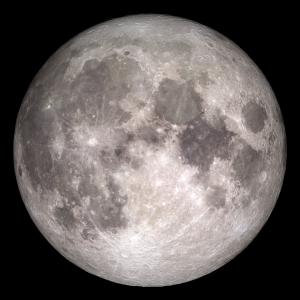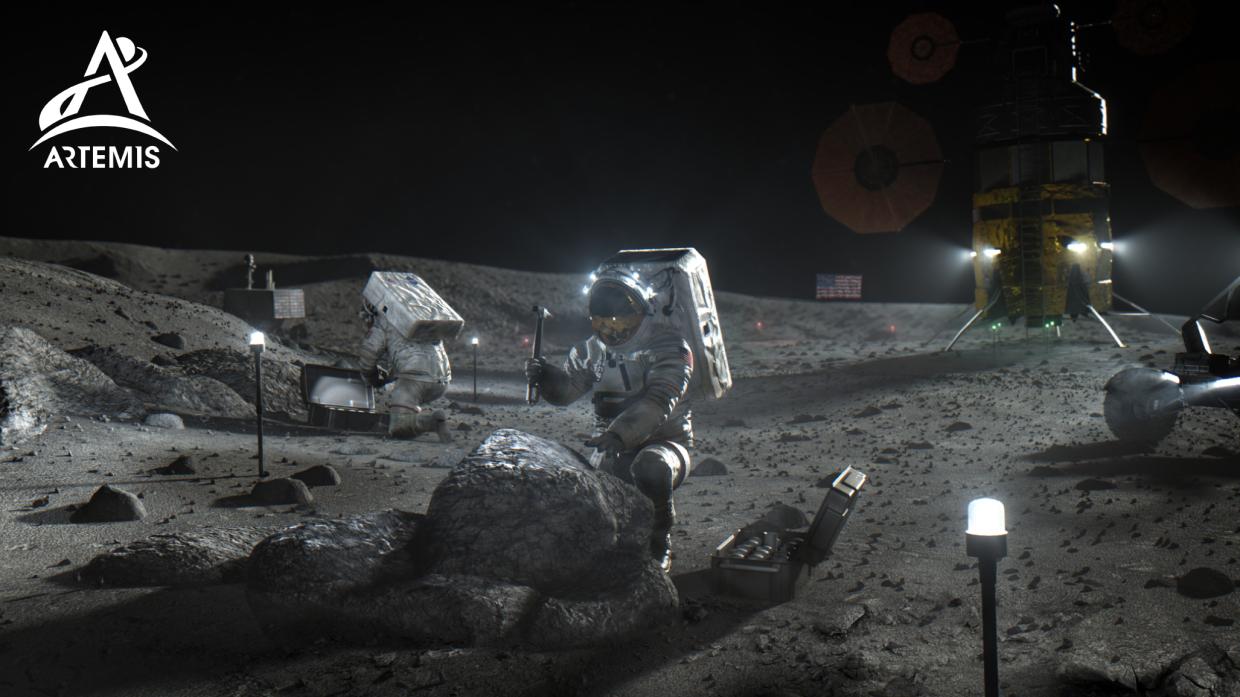
The NISE Network has compiled the following resources to help engage the public in the Moon, the Apollo missions and Artemis missions.
Hands-on Moon activities
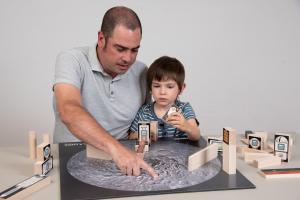
- NISE Network hands-on moon activities and the year of the Explore Science: Earth & Space toolkit year is noted below:
- Voyage through the Solar System: Build a Moon Base Camp (2023)
- Voyage through the Solar System: Space Souvenir (2023)
- Voyage through the Solar System: Breath of Fresh Air (2023)
- Exploring the Solar System: Moonquakes (2020)
- Exploring the Solar System: Story Blocks (2020)
- Exploring the Solar System: Observe the Moon (2020)
- Exploring the Solar System: Hide and Seek Moon (2018)
- Exploring the Solar System: Big Sun, Small Moon (2017)
- Exploring the Solar System: Pocket Solar System (2019)
- Breakfast Moon picture book by Meg Grower and illustrated by David Barker (2019)
- Exploring the Solar System: Craters (2018)
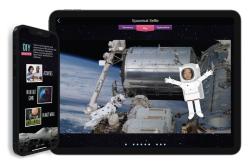
DIY Solar System App
The DIY Solar System app makes it easy for families and educators to explore the solar system from anywhere, anytime!
Moon Adventure Game
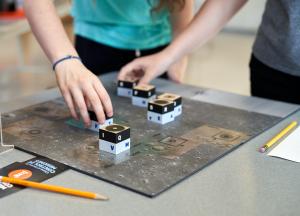
- NISE Network has created a collaborative game where players work together to solve a series of challenges about living and doing research on the Moon.
Moon Adventure Game
https://www.nisenet.org/moongame
Additional Earth & Space Activities
- NISE Network Earth & Space toolkits of hands-on activities
digital versions of toolkits are available as a free download:- 2017 Explore Science: Earth & Space toolkit: www.nisenet.org/earthspacekit-2017
- 2018 Explore Science: Earth & Space toolkit: www.nisenet.org/earthspacekit-2018
- 2019 Explore Science: Earth & Space toolkit: www.nisenet.org/earthspacekit-2019
- 2020 Explore Science: Earth & Space toolkit: www.nisenet.org/earthspacekit-2020
- More NISE Network hands-on activities
- Molecules in Motion explores how materials behave and change in a vacuum (included in 2018 Explore Science: Let's Do Chemistry kit)
- Rocket Reactions (included in 2018 Explore Science: Let's Do Chemistry kit)
- Exploring Nano & Society - Space Elevator (included in 2017 NanoDays kit)
- NASA and more hands-on activities
- Make a Moon Phases Calendar and Calculator from NASA JPL
- More activities and resources from NASA JPL
- Lunar Planetary Institute (LPI) has several hands on activities
https://www.lpi.usra.edu/education/resources/s_system/moon.shtml - STARnet library program has compiled a list of hands on activities
http://clearinghouse.starnetlibraries.org/125-moon - NASA eClips activities and videos
https://nasaeclips.arc.nasa.gov/search/?terms=moon - Night Sky Network activities and printable take home materials
https://nightsky.jpl.nasa.gov/download-view.cfm?Doc_ID=639
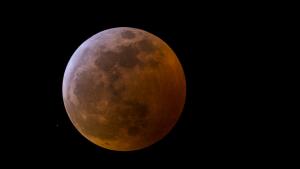
Lunar Eclipse resources
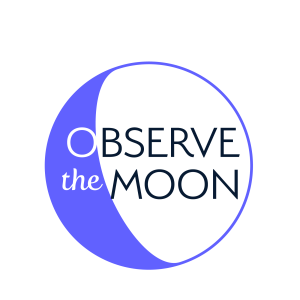
Observing the Moon
- Moon Viewing Guides
- NISE Network activities:
- International Observe the Moon Night
(annual event in September or October)
Finding STEM Experts
- Finding and Collaborating with STEM Experts: see the "Space and Earth Science" section of the Working with STEM Experts: A Guide for Educators in Museums and Other Informal Learning Settings
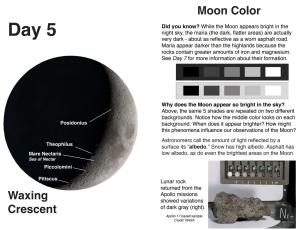
Printable take home handouts for the public
- Night Sky Network Exploring Moon Phases cards - Print these and fold in half for an easy to use, informative lunar observing resource. https://nightsky.jpl.nasa.gov/docs/MoonPhaseCardsASP.pdf
- Night Sky Network Skywatcher's Guide to the Moon to identify features on the moon
https://nightsky.jpl.nasa.gov/download-view.cfm?Doc_ID=331 - NASA Moon Phase Calendar
https://www.jpl.nasa.gov/edu/learn/project/make-a-moon-phases-calendar-and-calculator/ - NASA's "Forward to the Moon with Artemis" activity booklet
https://www.nasa.gov/stem-content/forward-to-the-moon-with-artemis-explorer-activities/
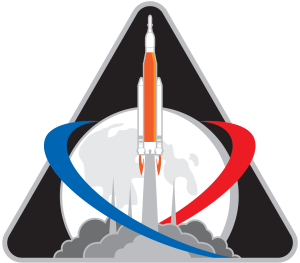
NASA Artemis Program
NASA is committed to landing American astronauts, including the first woman and the first person of color on the Moon under the Artemis program. https://www.nasa.gov/specials/artemis/
- NASA’s Office of STEM Engagement (OSTEM) Artemis resources - this website consolidates all of the best Artemis themed activities, curriculum guides, challenges and student/educator opportunities in one place https://stem.nasa.gov/artemis/
- Artemis Outreach and Educational downloadable materials
- Artemis Multimedia Catalog for downloadable digital resources for exhibits, print products, presentations, videos or other digital media
- Artemis story products (talking points and powerpoint presentations) that lay out the architecture and mission goals in a clear and easy to follow narrative that is engaging and inspiring to the public
- Artemis I Launch and Splashdown Event Planning Guide
- Artemis II resources
https://www.nasa.gov/artemis-ii - Artemis II Media Resources
https://www.nasa.gov/content/artemis-ii-media-resources - You are Going book
https://www.nasa.gov/you-are-going/ - First Woman graphic novel
https://www.nasa.gov/specials/calliefirst/ - Latest Artemis news: https://blogs.nasa.gov/artemis/
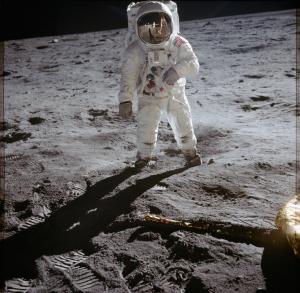
NASA Moon general resources
- NASA Science – Earth’s Moon
https://www.nasa.gov/moon - NASA and International Moon Missions Timeline
https://moon.nasa.gov/exploration/moon-missions/
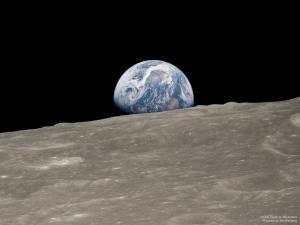
Image Credit: NASA,
Apollo 8 Crew, Bill Anders;
Processing and License:
Jim Weigang
Logos, Images, and Artwork
- Internal Observe the Moon Night logos
- Artemis
Photos and images of the Moon
- NASA moon gallery
https://moon.nasa.gov/galleries/images - Lunar Images and Maps
https://www.lpi.usra.edu/lunar/lunar_images/ - Panoramic Lunar surface images (Apollo 11-17)
https://www.lpi.usra.edu/resources/apollopanoramas/ - Iconic photos and spacecraft diagrams from the Apollo missions (Apollo 1 - Apollo 17)
https://airandspace.si.edu/explore-and-learn/topics/apollo/apollo-program/images/
Posters
- NASA Moon poster and virtual backgrounds
https://science.nasa.gov/science-explorers - NASA printable Moon poster
https://science.nasa.gov/resource/earths-moon-poster-version-a/ - "To the Moon and Beyond," "How Our Moon Formed," and "Our Moon in a New Light: posters from the Lunar Planetary Institute (LPI)
https://www.lpi.usra.edu/education/moonPosters/ - Earth Rise and Blue Marble posters from the Lunar Planetary Institute (LPI)
https://www.lpi.usra.edu/apollo50/ - NASA Moon posters and graphics:
https://moon.nasa.gov/galleries/graphics - NASA Solar System Exploration Poster set
https://solarsystem.nasa.gov/resources/925/solar-system-and-beyond-poster-set/ - Destination Moon poster exhibition from Smithsonian Institution Traveling Exhibition Service (SITES). The posters are available in either print or digital download. You may reserve a printed copy of the poster exhibition, or immediately download high-resolution digital files.
https://www.sites.si.edu/s/topic/0TO1Q000000MBVDWA4/destination-moon-the-apollo-11-mission-poster-exhibition
Books for Story Times and Programs
- Breakfast Moon picture book by Meg Grower and illustrated by David Barker (book was included in the Explore Science: Earth & Space 2019 toolkit)
- Happy Birthday, Moon Asch, F. (2014). Aladdin.
- Science Adventures with Max the Dog Series Bennett, Jeffrey (2008-2015). Big Kid Science. Grades 2-4; fiction
- Faces of the Moon Crelin, B. (2009) Watertown, MA: Charlesbridge. Grades 1 – 4
- Moon Base Alpha Series Gibbs, Stuart (2013-2016). Simon & Schuster Books for Young Readers. Grades 3-7; fiction
- The Moon and how to observe it Grego, P. (2016). Firefly Books. (ISBN-13: 978-1770857155) Appropriate for older youth and adults
- A Moon of My Own Rustgi, Jennifer (2016). Dawn Publications (ISBN-13: 978-1584695738) Grades PreK- 3.
- Moon: a Peek-Through Picture Book Teckentrup, B. (2018). Random House Children’s Books.
- Phrases of the Moon Lewis, J. Patrick. 2018. [S.I.]: Creative Co.
- Hello to You, Moon Morgan, Sally. 2018. [S.I.] Little Hare
Library resources
- Books, Reading, and Storytelling resources
https://www.nisenet.org/books
Moon cultural stories
- The Astronomy of Many Cultures: A Resource Guide compiled by Andrew Fraknoi
- NASA's Universe of Learning Native American Sky resources:
https://universe-of-learning.org/contents/events/science-briefings/science-briefing-the-native-american-sky - Audio stories about the Moon from Lunar Planetary Institute (LPI)
https://www.lpi.usra.edu/education/explore/marvelMoon/tales/ - Moon myths from around the world - Night Sky Network and Astronomical Society of the Pacific (ASP)
https://nightsky.jpl.nasa.gov/download-view.cfm?Doc_ID=642
Downloadable handout: https://nightsky.jpl.nasa.gov/docs/MoonStoriesASP2019.pdf
Create your own Moon story handout: https://nightsky.jpl.nasa.gov/docs/CreateMoonStory.pdf - Cosmic Serpent - Bridging Native Ways of Knowing and Western Science in Museum Settings
https://www.informalscience.org/sites/default/files/CS-LegacyDoc27Nov2012.pdf - Native Sky Watchers - Two Eyed Seeing – NASA & Indigenous Astronomy – For the Benefit of All
https://www.nativeskywatchers.com/two-eyed-seeing-nasa.html - Indigenous Education Institute (IEI): http://indigenouseducation.org
- Smithsonian National Museum of the American Indian Star Stories:
https://www.youtube.com/playlist?list=PLS6nSmuURFJBLIE-4ulPJMYxOV4Zpj1WZ - Learn more about Indigenous ways of knowing and making local connections in the NISE Network guide Working with STEM Experts: A Guide for Educators in Museums and Other Informal Learning Settings
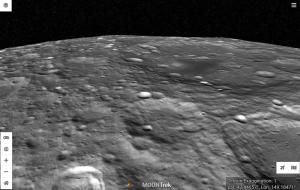
Multimedia and interactive resources
- Moon Trek: Explore all the details of the Moon, generate 3D printed models of the landscape, and download the highest resolution images available
https://trek.nasa.gov/moon/index.html - NASA's Eyes on the Solar System: Explore our solar system including our Moon! Using real trajectory data you can recreate famous moments in solar system exploration, or preview exciting adventures yet to come.
https://science.nasa.gov/eyes/ - Explore landing sites and geography of the moon: https://moon.nasa.gov
- Interactive Maps (Lunar Reconnaissance Orbiter Camera (LROC))
https://quickmap.lroc.asu.edu
Explore the Moon with NASA Eyes.
https://eyes.nasa.gov/apps/orrery/#/moon
Augmented Reality (AR) and Virtual Reality (VR)
- NASA Moon Trek Favorite Fly Alongs:
NASA Moon Trek can be used with Google Cardboard of VR Goggles- Virtual Reality Library: NASA Solar System Treks has developed a set of favorite fly-alongs including Apollo landing sites on the Moon and possible future landing sites on the Moon
- Go to https://trek.nasa.gov and scroll down to "Virtual Reality Library"
- Instructions: Watch the video of how to use QR codes with Trek Virtual Reality and find links to the "Virtual Reality Library" of tours
- NASA Moon Trek Custom Virtual Reality tours can be created
NASA Moon Trek can be used with Google Cardboard of VR Goggles- https://trek.nasa.gov/moon/
- Instructions: Open the Tools panel to draw a path to float along with full 360 views. You can also watch a video about using QR codes, watch the short video below to see how it works with Trek Virtual Reality: https://trek.nasa.gov
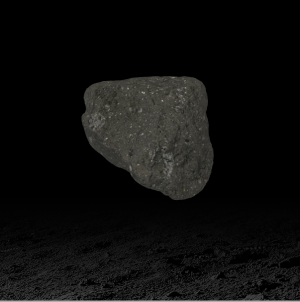
3D images of lunar and meteorite samples
- A virtual library for exploration and research of NASA's space rock collections
https://ares.jsc.nasa.gov/astromaterials3d/
3D printing resources
- 3D printable lunar models including Apollo landing sites
https://nasa3d.arc.nasa.gov/search/lunar - Custom 3D print files can be generated using the NASA Moon Trek; users can draw bounding boxes around any areas of interest to generate output files for 3D printing of desired surface features
https://trek.nasa.gov/moon/
instructions: https://trek.nasa.gov (choose "3D printing" from menu at the bottom of the screen
Apollo Moon Landing Anniversary
During the Apollo program of the 1960s and '70s, NASA sent nine missions to the Moon. Six of them landed astronauts safely on the surface, the only times humans have visited another world. July 20, 2019 marked the 50th anniversary of the first humans landing on the Moon on July 20, 1969 as part of NASA's Apollo 11 lunar mission.
What was the Apollo program?
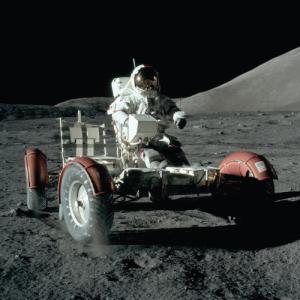
- NASA Knows! (Grades 5-8) series
https://www.nasa.gov/audience/forstudents/5-8/features/nasa-knows/what-was-apollo-program-58.html
NASA Knows! (Grades K-4) series
https://www.nasa.gov/audience/forstudents/k-4/stories/nasa-knows/what-was-apollo-program-k4.html - Summary of the purpose of each of the different Apollo missions (Apollo 1 - Apollo 17)
https://airandspace.si.edu/explore-and-learn/topics/apollo/apollo-program/ - NASA Apollo Program
https://www.nasa.gov/mission_pages/apollo/index.html - NASA Apollo 11 mission
https://www.nasa.gov/mission_pages/apollo/apollo-11.html
Apollo Moon Landing volunteer and staff orientation slides
- Presentation Powerpoint Slides: NISE Network overview slides to familiarize volunteers and staff about the Moon landing, Apollo missions, and ongoing lunar scientific research (included in the NISE Network 2019 Earth & Space toolkit)
http://www.nisenet.org/catalog/moon-nasa-going-back-and-looking-forward-presentation - Video - Apollo landing sites visualization video produced by NASA's Moon Trek team (included in the NISE Network 2019 Earth & Space toolkit). Closed Captions are now available, see the video's description on Vimeo for more information on how to access them.
https://vimeo.com/317054974 - Night Sky Network amateur astronomer slides from Astronomical Society of the Pacific "To the Moon" presentation
https://nightsky.jpl.nasa.gov/download-view.cfm?Doc_ID=639
Moon Landing and Apollo's Anniversary resources
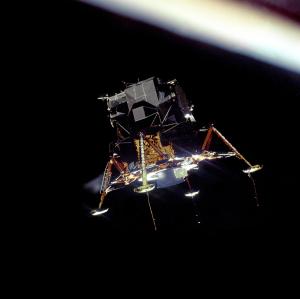
- NASA Apollo 50th anniversary resources
https://www.nasa.gov/specials/apollo50th/ - NASA Apollo anniversary resources
https://science.nasa.gov/toolkits/apollo-anniversary - Lunar Planetary Institute resources
https://www.lpi.usra.edu/apollo50/
Online Workshops for educators
- NISE Network Online Workshop: Celebrating the Moon, Our Nearest Neighbor in Space (October 2018 - Recorded)
- NISE Network Online Workshop: Big or Small, Make Your Apollo 50th Anniversary Celebration Events a Moonshot! - (May 14, 2019 Recorded)
- NASA Museum & Informal Education Alliance workshop Preparing for the Apollo 50th Anniversaries (July 2018 - Recorded)
(you must register to access NASA Museum & Informal Education Alliance resources)
Event planning resources
- Earth & Space event planning guide
- NISE Network Online Workshops (recorded)
- NISE Network Online Workshop: Celebrating the Moon, Our Nearest Neighbor in Space (October 2018 - Recorded)
NISE Network Online Workshop: Big or Small, Make Your Apollo 50th Anniversary Celebration Events a Moonshot! - (May 14, 2019 Recorded)
Apollo Moon Landing volunteer and staff orientation slides
- Presentation Powerpoint Slides: NISE Network overview slides to familiarize volunteers and staff about the Moon landing, Apollo missions, and ongoing lunar scientific research (included in the NISE Network 2019 Earth & Space toolkit)
http://www.nisenet.org/catalog/moon-nasa-going-back-and-looking-forward-presentation - Video - Apollo landing sites visualization video produced by NASA's Moon Trek team (included in the NISE Network 2019 Earth & Space toolkit). Closed Captions are now available, see the video's description on Vimeo for more information on how to access them.
https://vimeo.com/317054974 - Night Sky Network amateur astronomer slides from Astronomical Society of the Pacific "To the Moon" presentation
https://nightsky.jpl.nasa.gov/download-view.cfm?Doc_ID=639
Moon landing Images and Videos
- NASA Apollo 11 Moonwalk Montage - July 20, 1969: One Giant Leap For Mankind
https://www.nasa.gov/mission_pages/apollo/apollo11.html - NASA videos about the Moon and Apollo missions
https://moon.nasa.gov/galleries/videos - Video - Apollo landing sites visualization video produced by NASA's Moon Trek team (included in the NISE Network 2019 Earth & Space toolkit)
https://vimeo.com/317054974 - Videos of Lunar Landing sites (Lunar Reconnaissance Orbiter Camera (LROC))
http://lroc.sese.asu.edu/images/videos - Fiske Planetarium videos
https://www.colorado.edu/fiske/about-us/fiske-productions
Free higher resolution files available for download to planetariums- "NASA Explorations episode5 Apollos Legacy: Rocks from the Moon" (8 minutes)
- "Moon Dome" short loop showing full Moon to new Moon (2 minutes)
- "Max Goes to the Moon" planetarium show (35 minutes)
- NASA eClips video - Our World: Moon Phases (3 minutes) (Grades K-5)
https://nasaeclips.arc.nasa.gov/video/ourworld/our-world-moon-phases - NASA eClips video - Our World: The Moon's Impact on Earth (3 minutes) (Grades K-5)
https://nasaeclips.arc.nasa.gov/video/ourworld/our-world-the-moons-impact-on-earth - NASA eClips video - Launchpad: Apollo 11 - Challenges of Landing on the Moon (6 minutes)
https://nasaeclips.arc.nasa.gov/video/launchpad/launchpad-apollo-11-challenges-of-landing-on-the-moon - NASA eClips video - Our World: Lunar Rock - Lunar Sample Laboratory Facility in Houston, Texas (4.5 minutes)
https://nasaeclips.arc.nasa.gov/video/ourworld/our-world-lunar-rock - Apollo 11 Video Library
https://www.hq.nasa.gov/alsj/a11/video11.html
Moon landing films
- PBS "Earth Rise" film - Apollo 8
https://www.pbs.org/pov/earthrise/ - PBS NOVA "Apollo's Daring Mission"
https://www.pbs.org/wgbh/nova/video/apollos-daring-mission
Planetarium Shows
- Fiske Planetarium videos
Free higher resolution files available for download to planetariums
https://www.colorado.edu/fiske/about-us/fiske-productions - "NASA Explorations episode5 Apollos Legacy: Rocks from the Moon" (8 minutes)
- "Moon Dome" short loop showing full Moon to new Moon (2 minutes)
- "Max Goes to the Moon" planetarium show (35 minutes)
- More fee-based planetarium shows
https://www.ips-planetarium.org/page/fulldomemasters
NASA Visualizations of the Moon and Apollo program
- Video - Apollo landing sites visualization video produced by NASA's Moon Trek team (included in the NISE Network 2019 Earth & Space toolkit)
https://vimeo.com/317054974 - Revisiting The Moon Landing
https://svs.gsfc.nasa.gov/11679 - Tour of the Moon 4K Redux
https://svs.gsfc.nasa.gov/4619 - Staring Into Darkness (NASA’s Scientific Visualization Studio)
https://svs.gsfc.nasa.gov/11230 - Peeking Into Lunar Pits (NASA’s Scientific Visualization Studio)
https://svs.gsfc.nasa.gov/cgi-bin/details.cgi?aid=11612 - Earthrise (NASA’s Scientific Visualization Studio)
https://svs.gsfc.nasa.gov/4593/
Historical Image and Videos Collections of the Apollo program
- The Apollo Program
Smithsonian National Air and Space Museum
https://airandspace.si.edu/explore-and-learn/topics/apollo/apollo-program/ - Apollo 11 Image Library
https://www.hq.nasa.gov/alsj/a11/images11.html - Apollo 11 Video Library
https://www.hq.nasa.gov/alsj/a11/video11.html - Apollo 11 Lunar Surface Journal
https://www.hq.nasa.gov/alsj/a11/a11.html
Snoopy - Peanuts - Charlie Brown connection
In May 1969, Apollo 10 astronauts traveled all the way to the Moon for one final checkout before the lunar landing attempt. Because the mission required the lunar module to skim the Moon's surface to within 50,000 feet and "snoop around" scouting the Apollo 11 landing site, the crew named the lunar module "Snoopy." The Apollo command module was labeled "Charlie Brown." There are some new resources you may want to use for your events:
- Lesson Plans Grades K-5 and worksheets (free access)
http://ymiclassroom.com/lesson-plans/peanuts-nasa/ - NASA Museum & Informal Education Alliance resources held a February 2019 webinar and has posted presentation available for download about Peanuts assets: https://informal.jpl.nasa.gov/museum/peanuts
(you must register to access NASA Museum & Informal Education Alliance resources)

